Causes
| | This section needs expansion. You can help by adding to it. (January 2017) |
The cause of the floods was during the impact of three depressions monitored by PAGASA (Auring, Bising and Crising).[ citation needed ]
| Date | January 16 – February 10, 2017 [1] |
|---|---|
| Location | Eastern Visayas and Northern Mindanao, Philippines |
| Deaths | 9 |
| Property damage | 1,300 houses |
The 2017 Visayas and Mindanao floods was an event that caused extreme flooding within parts of the Philippines, caused by several low-pressure systems. In mid-January 2017, several parts of Visayas and Mindanao experienced flooding as a result of a low-pressure area, combined with the tail-end of a cold front. [2]
| | This section needs expansion. You can help by adding to it. (January 2017) |
The cause of the floods was during the impact of three depressions monitored by PAGASA (Auring, Bising and Crising).[ citation needed ]
The city of Cagayan de Oro was seriously affected by the floods, as the heavy rain started in the early afternoon and continued late into the evening on Monday, January 16, inundating several streets and stranding many commuters. [2] [3] Hundreds of students were trapped at the University of Science and Technology of Southern Philippines (USTP) due to the floodwaters without any food or water. With most of the campus flooded, students were forced to head to the upper floors of the school's buildings. [4]
Shopping malls along Claro M. Recto Avenue were hit by the floodwaters as well; Limketkai Center was rendered completely impassable. [5] One mall's basement parking area was filled with water, while another mall near Bitan-ag Creek was also flooded, despite the area already being elevated. [6]
As a result of the heavy rain in Cagayan de Oro, parts of Camaman-an, Patag, Carmen, and a number of urban barangays were swamped by the deluge. [2] Two landslides were reported in the city; one on Masterson Avenue near Pryce Plaza Hotel, and in Paglaum Village, Camaman-an. [6] The City Disaster Risk Reduction and Management Department (CDRRMD) said that a rain gauge near the Cagayan River recorded a total of 166.2 mm, [2] about 20 mm less than the amount of rainfall recorded in December 2011 when Tropical Storm Sendong (Washi) impacted the city. [7] However, the two-day rainfall amount was higher than that from both Tropical Depression Agaton (Lingling) and Tropical Storm Seniang (Jangmi). [8]
Numerous business establishments and schools opened their doors to people unable to return home because of the floods. This included Centrio Mall, SM City Cagayan de Oro and Limketkai Mall which remained open after hours, and Xavier University, which made its canteen, a number of classrooms and covered courts as a temporary refuge. [9]
Floods also affected the provinces of Bohol, Cebu, Negros Oriental, Misamis Oriental, Lanao del Sur and Bukidnon. [10] Landslides were also reported in several parts of Visayas and Mindanao. [11] [12]
Classes were suspended in Tacloban, Leyte, Southern Leyte, and Misamis Oriental, [13] as well as parts of Samar, Northern Samar, Eastern Samar provinces. [14]
The local government of Cagayan de Oro declared a state of calamity over the city in the early morning of Tuesday, January 17, 2017. [15] On Thursday, January 19, as a result of the continuous rainfall, the Cagayan de Oro City Disaster Risk Reduction and Management Office (CDRRMO) declared a code yellow, asking residents to be vigilant. [10] At least seven people died in the city due to the floods. [16] [17]
A few days after the floods, it was reported that supplies of doxycycline, used to treat people against leptospirosis, had run out in Cagayan de Oro. A similar situation occurred in the aftermath of Tropical Storm Sendong when 24 people died because of an outbreak of leptospirosis. [18]
According to Department of Public Works and Highways (DPWH) secretary Mark Villar, the agency will ask the Department of Budget and Management (DBM) for an additional P300 million for the accelerated completion of various projects that are meant to reduce future flooding in Cagayan de Oro. Meanwhile, the DPWH was called into question by Senate President Aquilino Pimentel III for a lack of coordination with the City Government of Cagayan de Oro when implementing projects. [19] The agency also admitted that the recently completed bridge over Bitan-ag Creek failed to prevent neck-level floodwaters from inundating Limketkai Center and USTP. Due to garbage clogging the creek, mud and water spilled onto Claro M. Recto Avenue. [20]

Misamis Oriental, officially the Province of Misamis Oriental, is a province located in the region of Northern Mindanao in the Philippines. Its capital, largest city and provincial center is the city of Cagayan de Oro, which is governed independently from the province.

Opol, officially the Municipality of Opol, is a 2nd class municipality in the province of Misamis Oriental, Philippines. According to the 2020 census, it has a population of 66,327 people.
Lumbia Airfield, formerly known as Lumbia Airport and Cagayan de Oro Airport, is an air base and was the main airport that served the general areas of Cagayan de Oro and Northern Mindanao, in the province of Misamis Oriental in the Philippines. It was the second busiest airport in Mindanao, after Francisco Bangoy International Airport in Davao City before the opening of Laguindingan Airport.

The Roman Catholic Archdiocese of Cagayan de Oro is an archdiocese of the Catholic Church in the Philippines.
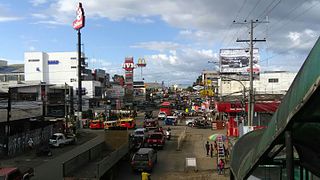
The Francis Bowes Sayre Sr. Highway or simply the Sayre Highway is a four-to-six lane, 192-kilometre (119 mi), primary national highway that connects Cagayan de Oro, Misamis Oriental to Kabacan, North Cotabato. It traverses the provinces of Misamis Oriental, Bukidnon and North Cotabato.

SM City CDO Uptown, is a shopping mall owned and operated by SM Prime Holdings, the largest mall operator in the Philippines. It is the first SM Supermall in Northern Mindanao. The mall, which is surrounded by subdivisions and condominiums, is located along Fr. Masterson Avenue corner Gran Via Street, Pueblo de Oro Township, Uptown Carmen, Cagayan de Oro, Misamis Oriental. It opened on November 15, 2002 with a total gross floor area of 99,837 square meters (1,074,640 sq ft) on a 5.2-hectare (13-acre) land.
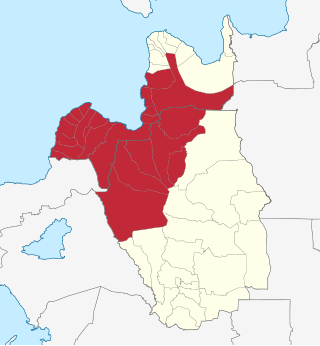
Metropolitan Cagayan de Oro, also known as Metro Cagayan de Oro, is the fourth largest metropolitan area in the Philippines. It is located on the northern coast of Mindanao, and comprises the two chartered cities of Cagayan de Oro and El Salvador and the fourteen municipalities of Misamis Oriental which are Alubijid, Balingasag, Claveria, Gitagum, Initao, Jasaan, Laguindingan, Libertad, Lugait, Manticao, Naawan, Opol, Tagoloan, and Villanueva and the six municipalities of Bukidnon which are Manolo Fortich, Baungon, Libona, Malitbog, Sumilao and Talakag. According to the 2015 Philippine census, Metro Cagayan de Oro has a population of 1,687,159 people.
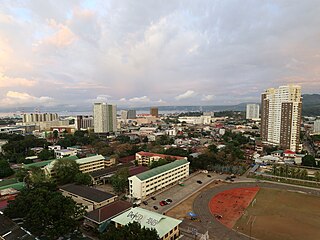
Cagayan de Oro (CDO), officially the City of Cagayan de Oro, is a 1st class highly urbanized city in the region of Northern Mindanao, Philippines. It is the capital of the province of Misamis Oriental where it is geographically situated but governed administratively independent from the provincial government. According to the 2020 census, it has a population of 728,402 people. Cagayan de Oro also serves as the regional center and business hub of Northern Mindanao, and part of the growing Metropolitan Cagayan de Oro area, which includes the city of El Salvador, the towns of Opol, Alubijid, Laguindingan, Gitagum, Lugait, Naawan, Initao, Libertad and Manticao at the western side, and the towns of Tagoloan, Villanueva, Jasaan, Claveria and Balingasag at the eastern side.
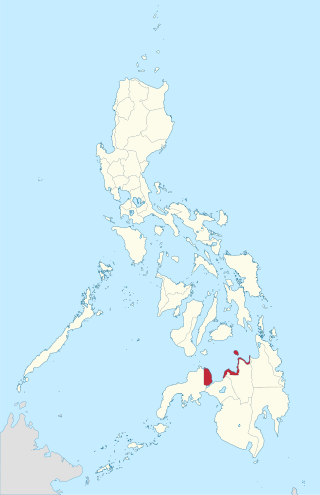
Misamis was a province of the Philippines located in Mindanao. Originally a Spanish-era district, became a chartered province on May 15, 1901. The province was dissolved in 1929.

Ayala Malls Centrio is an integrated mixed-use complex composed of a shopping mall, a hotel, a BPO/office building and a condominium tower located along Capt. Vicente Roa St. and Corrales Ave., cor. Claro M. Recto Avenue, Cagayan de Oro, Philippines.
DXCCRMN Cagayan de Oro is a radio station owned and operated by the Radio Mindanao Network. It serves as the flagship station of RMN Networks. The station's studio is located at RMN Broadcast Center, Don Apolinario Velez St., Cagayan de Oro, and its transmitter is located at Brgy. Taboc, Opol, Misamis Oriental.

Limketkai Center is a shopping mall in Cagayan de Oro, Philippines. Known by the locals as Ketkai, it is owned and developed by Limketkai and Sons, Inc., the largest factory and business district developer in the city.
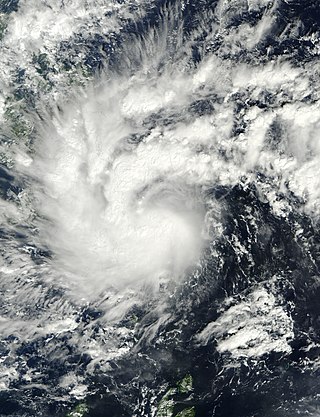
Severe Tropical Storm Washi, known in the Philippines as Tropical Storm Sendong, was a late-season tropical cyclone that caused around 1,200 to 1,500 deaths and catastrophic damage in the Philippines in late 2011. Washi made landfall over Mindanao, a major region in the Philippines, on December 16. Washi weakened slightly after passing Mindanao, but regained strength in the Sulu Sea, and made landfall again over Palawan on December 17.

SM CDO Downtown is a shopping mall located along Claro M. Recto Avenue corner Osmeña Street, Cagayan de Oro, in the city's central business district. It is owned and operated by SM Prime Holdings, the largest mall operator in the Philippines, and opened on May 12, 2017. The mall is the 2nd in Northern Mindanao and 61st mall in the Philippines by the SM Group. It was the 3rd SM Supermall to be called "Premier" after SM Lanang in 2012 and SM Aura in 2013 respectively. It has a leasable area of 81,133 m2 and a gross floor area of 177,743 m2, making it the largest SM Supermall in Mindanao.
National Route 10 (N10) is a 278-kilometer (173 mi) primary national route that forms part of the Philippine highway network and a spur of Asian Highway 26(AH26) of the Asian Highway Network. It connects the provinces of Misamis Oriental, Bukidnon and Davao del Sur.
DXFO, on-air as 103.9 Marian Radio, is a radio station owned and operated by the Archdiocese of Cagayan de Oro. The station's studio and transmitter are located at Our Lady of Fatima Parish, Hayes St., Brgy. Camaman-an, Cagayan de Oro.

DXIMRadyo Pilipinas is a radio station owned and operated by the Presidential Broadcast Service. The station's studio is located at Don Apolinar Velez, Brgy. Carmen, Cagayan de Oro, and its transmitter is located at the Fish landing Area of the Opol National Secondary Technical School, Brgy. Taboc, Opol, Misamis Oriental.

The COVID-19 pandemic in Northern Mindanao is part of the worldwide pandemic of coronavirus disease 2019 caused by severe acute respiratory syndrome coronavirus 2. The virus reached Northern Mindanao on March 11, 2020, when the first case of the disease was confirmed in Cagayan de Oro.

National Route 9 (N9) is a 416-kilometer (258 mi), two to six major primary route network connecting the provinces of connecting the provinces of Agusan del Norte, Misamis Oriental, Lanao del Norte, and Zamboanga del Sur.